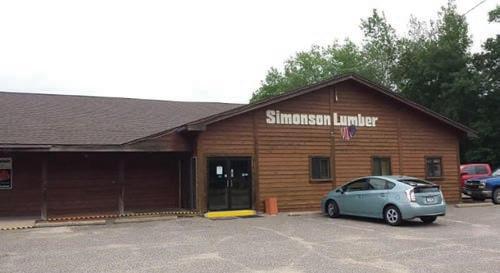IN Memoriam
Stimson Swapping Forests
William F. “Bill” Anderson, 65, president and chief operating officer of J.M. Thomas Forest Products, Ogden, Ut., passed away Feb. 27 following a longtime struggle with leukemia. A University of Northern Colorado graduate, he entered the industry in 1977. In 1993, he was recruited to join J.M. Thomas as a sales territory manager. He rose quickly up the ranks to an executive position and ultimately to president in 1999. Anderson was active in the North American Wholesale Lumber Association, serving on its board of directors twice, as chairman of the Traders Market committee, member of the education committee, and lead organizer in establishing the NAWLA 10 Groups. Fenton Norton Hord, former CEO of Stock Building Supply, Raleigh, N.C., died March 9. He was 74. A graduate of the University of Richmond and, for his MBA, Virginia C o m m o n w e a l t h U n i v e r s i t y, h e joined seven-unit Carolina Builders, Raleigh, in 1987 and within months
was promoted from executive vice president to CEO. He retired 20 years later after helping the chain, under the Stock banner, grow to 350 locations. He served on the boards of Wolseley PLC, Cornerstone Building Alliance, and the Jian Group. Edward Allen “Ed” Swift, 92, owner of Swift Trucking & Lumber Sales, Sutter Creek, Ca., died Feb. 1. At 16, he began working summers at Winton Lumber Co., Jackson, Ca., rising from laborer to yard boss to sales. In 1952 Ed inherited a 1944 Peterbilt log truck and started his own hauling and wholesaling business. Murphy Ainsworth, 28, former sales coordinator with Universal Forest Products, Fort Collins, Co., died March 3 in Denver, Co., after suffering a massive heart attack while jogging. A graduate of Butler University, he joined UFP in Grand Rapids, Mi., in 2015 as an e-commerce merchandiser, later transferring to Fort Collins and becoming an inside sales coordinator.
Assessment Increases for Softwood Checkoff The assessment for the Softwood Lumber Checkoff has increased from 35 cents to 41 cents per thousand board feet, effective April 1. The Softwood Lumber Board, which administers the program with oversight by the USDA, says the additional funds will allow it “to build on its success in maintaining and expanding markets for softwood lumber.” Assessments are collected from U.S. sawmills and importers and used for projects designed to increase the demand for softwood lumber within the U.S. With additional funds from the increase, the SLB will strengthen current programs and address gaps currently limiting the SLB’s ability to protect existing markets and expand market share for softwood lumber. Additionally, the funds will allow the SLB to: • Increase investments in core programs to ensure the successes in growing market share are not eroded by aggressive and disparaging competitor
Is this your copy? The
60
Subscribe to
MERCHANT Magazine n
The Merchant Magazine n
campaigns as well as recapturing share of voice taken by competitors. • Establish a wood education program targeting post-secondary architecture and engineering students and young professionals. • Expand trade training programs for general contractors and installers to address training gaps and skills development, specifically focused on mass timber and related lumber-based building systems. • Increase support for applied technical research, innovation, and early-adopter programs to maximize and leverage public and private funding. “The SLB welcomes the news approving the assessment increase,” said Cees de Jager, SLB president and CEO. “The additional investment from the lumber industry enables the SLB to build on the successful program it has established over the past nine years, and pursue new initiatives that leverage softwood lumber’s unique value proposition to solidify its position in an ever evolving market.” According to SLB, its investments have generated over 7.5 billion bd. ft. in demand since its inception, delivering an average ROI of $25.22 for every $1 spent.
April 2021
Stimson Lumber Co., Portland, Or., is negotiating a deal to swap 60,000 acres of its land with approximately 30,000 acres of land currently managed by the Colville National Forest. The potential exchange was initiated when Stimson approached the Forest Service with a proposal to consolidate the relatively fragmented landscape of ownership and management in northeast Washington. Stimson currently owns several thousand acres of inholdings within the proclaimed boundaries of the Colville and Kaniksu National Forests, and Little Pend Oreille National Wildlife Refuge in Pend Oreille and Stevens County, Wa. Most of Stimson’s acreage involved in the potential land exchange is part of the checkerboard pattern of ownership granted to Burlington Northern Railroad during the railroad land grants of the mid-1800s. The remaining acreage consists of inholdings acquired by Stimson and their predecessors. This fragmented ownership presents several unique management challenges, along with a continuing need to maintain or develop property lines and cooperative agreements between Stimson and adjoining landowners. For these reasons, along with the potential to consolidate timber and land resources, Stimson proposed an exchange with the U.S., which would benefit both parties’ resource management objectives and provide economic stability to nearby communities that rely on sustainable forest industries. Lands acquired by the U.S. through the deal would include culturally significant properties as well as habitats for important wildlife and fish species. Creating connected and contiguous areas of public land could enhance opportunities for recreation, forest restoration, management of resources, as well as fire preparedness, suppression and protection. Consolidated ownership of land would provide better opportunities to manage property boundaries, leading to less public confusion. The Forest Service is currently developing the exchange proposal and performing initial review for feasibility—the first stage of a lengthy process which could lead to the title transfer of lands.
Building-Products.com


















